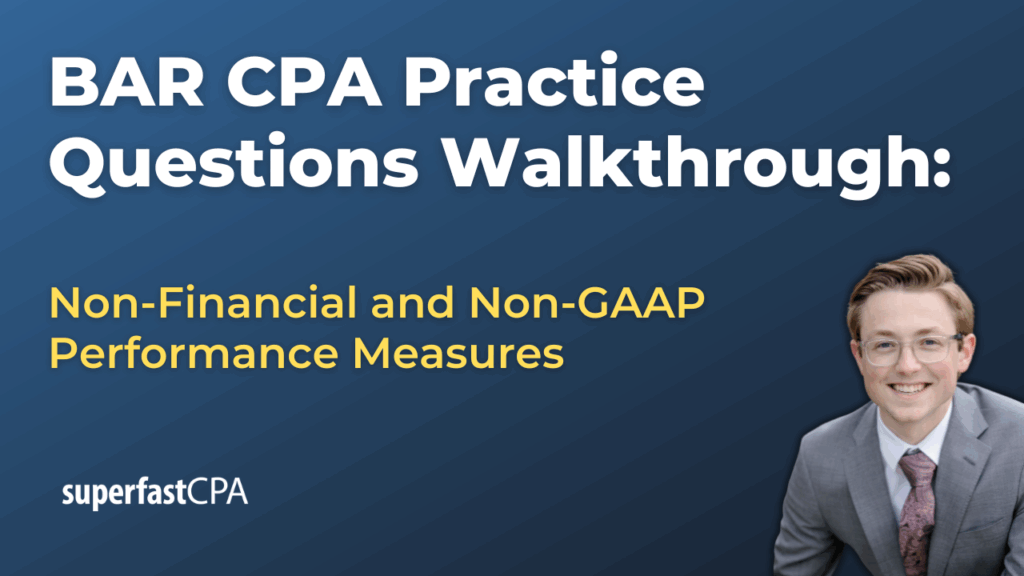In this video, we walk through 5 BAR practice questions teaching about non-financial and non-GAAP performance measures. These questions are from BAR content area 1 on the AICPA CPA exam blueprints: Business Analysis
The best way to use this video is to pause each time we get to a new question in the video, and then make your own attempt at the question before watching us go through it.
Also be sure to watch one of our free webinars on the 6 “key ingredients” to an extremely effective & efficient CPA study process here…
Non-Financial and Non-GAAP Performance Measures
The BAR exam tests candidates on a wide range of performance analysis tools—many of which go beyond traditional financial statements. One critical topic is the ability to identify relevant non-financial and non-GAAP measures used to analyze an entity’s performance. This post provides a structured overview of this topic, including examples and practical insights, with a particular emphasis on quality costs.
Non-Financial Performance Measures: A Broader View of Business Performance
Non-financial performance measures assess aspects of a company’s operations that are not captured by dollar-based accounting. These metrics offer insight into the factors that drive financial results and long-term sustainability. Unlike standard financial ratios, non-financial metrics track operational effectiveness, customer satisfaction, and internal process quality.
Common examples include:
- Product defect rate
- On-time delivery rate
- Employee turnover percentage
- Customer satisfaction index
- Inventory accuracy
These measures are often forward-looking and serve as early indicators of future financial outcomes. For instance, a rise in customer complaints may precede declining sales or increased return rates.
Non-GAAP Performance Measures: Adjusted Views of Financial Results
Non-GAAP performance measures are company-specific metrics that adjust Generally Accepted Accounting Principles (GAAP) financial results to provide a clearer picture of “core” performance. These measures exclude certain items that management considers nonrecurring, unusual, or not reflective of ongoing operations.
Common non-GAAP measures include:
- EBITDA (Earnings Before Interest, Taxes, Depreciation, and Amortization)
- Adjusted Net Income
- Free Cash Flow
- Core Operating Income
While these measures can offer useful insight, they are not standardized. Candidates should be prepared to evaluate their relevance and understand potential limitations in consistency or comparability.
Linking Quality Costs to Non-Financial Performance Metrics
A key area of non-financial analysis frequently tested on the BAR exam involves the concept of quality costs. These are operational metrics, often expressed in dollar terms, used not for financial reporting but for managing internal efficiency and customer outcomes.
Quality costs are typically categorized into four types:
- Prevention Costs
- Appraisal Costs
- Internal Failure Costs
- External Failure Costs
Although these are technically financial amounts, their purpose is to evaluate operational performance. They are best understood as part of a broader non-financial performance management system.
Conformance Costs
Conformance costs include:
- Prevention costs: incurred to avoid defects, such as training programs and preventive maintenance.
- Appraisal costs: incurred to detect defects before products are delivered, such as inspections and quality audits.
These costs are intended to maintain quality and reduce the occurrence of errors. For example, if a company spends $10,000 on preventive maintenance and $8,000 on quality training, both amounts represent prevention costs.
Nonconformance Costs
Nonconformance costs arise when the quality system fails and defects occur:
- Internal failure costs: costs of rework or scrap identified before shipping.
- External failure costs: costs related to defects discovered after delivery, including warranty claims, product returns, and loss of customer goodwill.
These costs can negatively affect customer satisfaction and operational efficiency, making them essential non-financial performance indicators.
The Relationship Between Conformance and Nonconformance Costs
A major insight is the inverse relationship between conformance and nonconformance costs. In many organizations, increasing spending on prevention and appraisal efforts (conformance costs) can lead to a decrease in failure-related costs (nonconformance costs).
For example:
- Last year: $80,000 in conformance costs and $120,000 in nonconformance costs.
- This year: Conformance costs increased by 25%, and nonconformance costs decreased by 20%.
This shift suggests that quality initiatives are becoming more effective. The improvement in internal systems, even though associated with higher upfront costs, resulted in fewer defects and lower downstream failure costs. These kinds of metrics offer a more complete view of performance than financial statements alone.
Summary of Key Concepts
To solidify your understanding, keep the following core principles in mind:
- Non-financial performance measures focus on operational drivers like quality, efficiency, and customer satisfaction.
- Non-GAAP performance measures are company-defined financial metrics that provide adjusted views of operations, such as EBITDA or Adjusted Net Income.
- Conformance costs (prevention and appraisal) are proactive expenses aimed at maintaining quality and should be evaluated as performance metrics, not simply expenses.
- Nonconformance costs (internal and external failure) are reactive costs that indicate system weaknesses and impact customer trust and future sales.
- Effective investment in conformance activities can lead to measurable reductions in nonconformance costs—supporting a more sustainable, efficient, and customer-focused operation.









